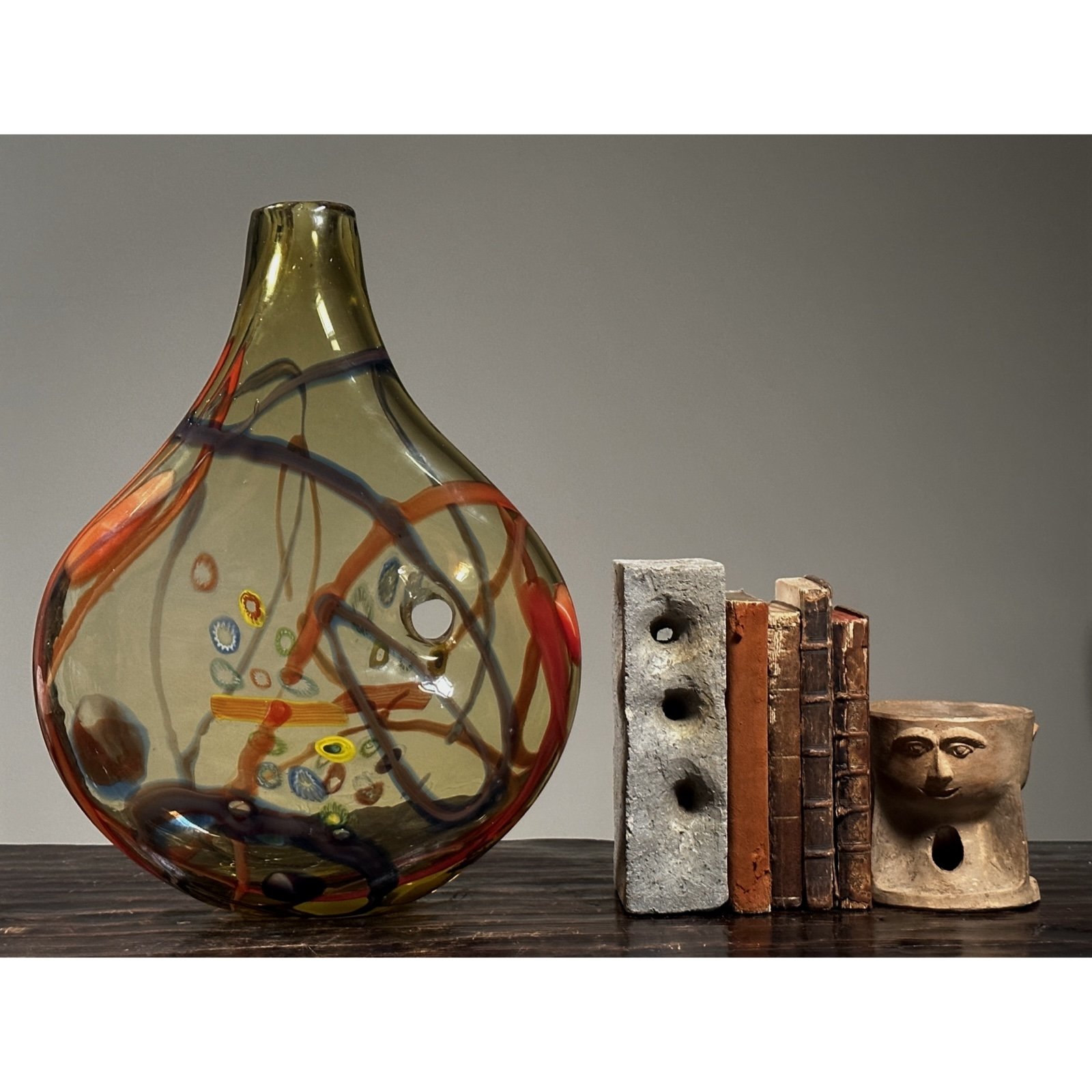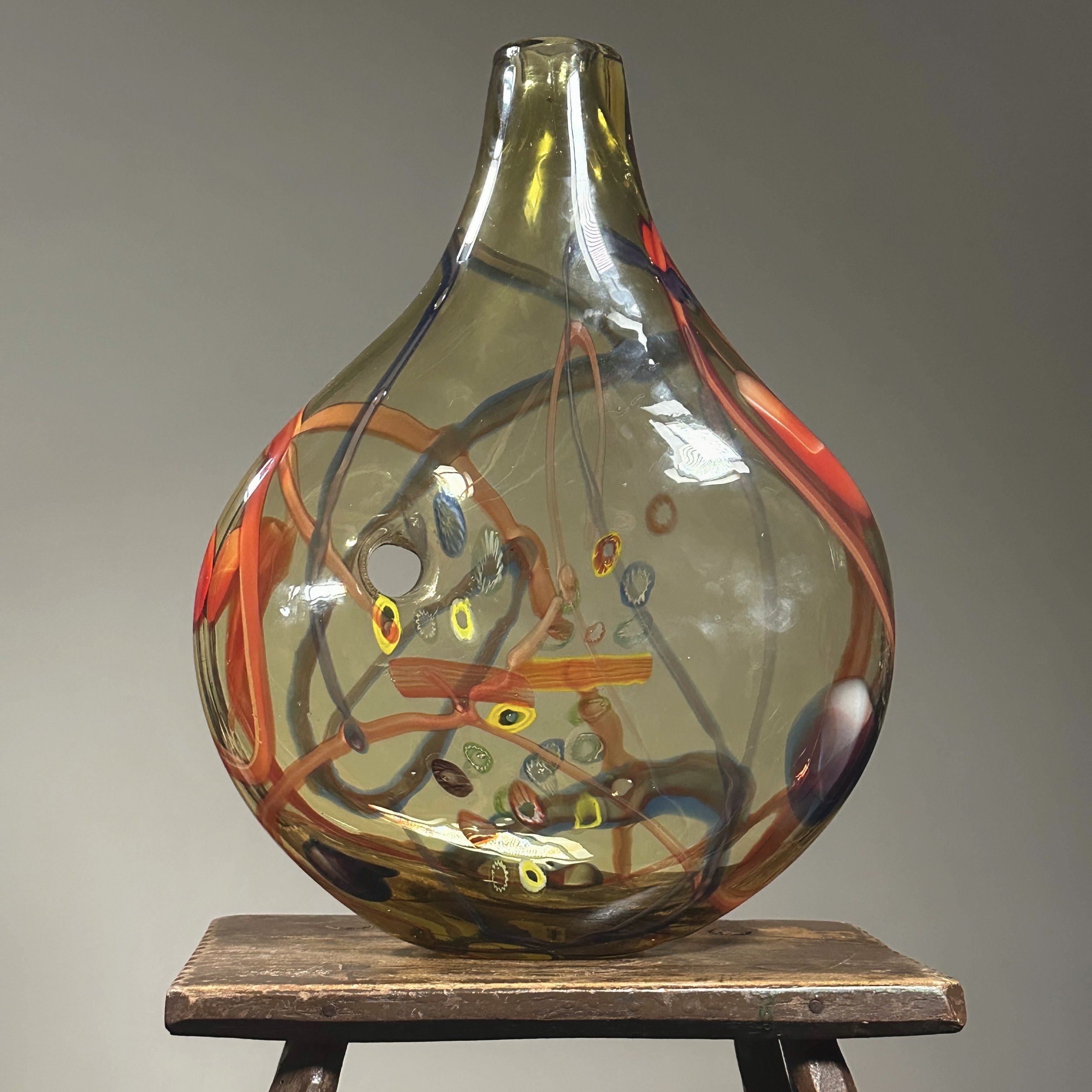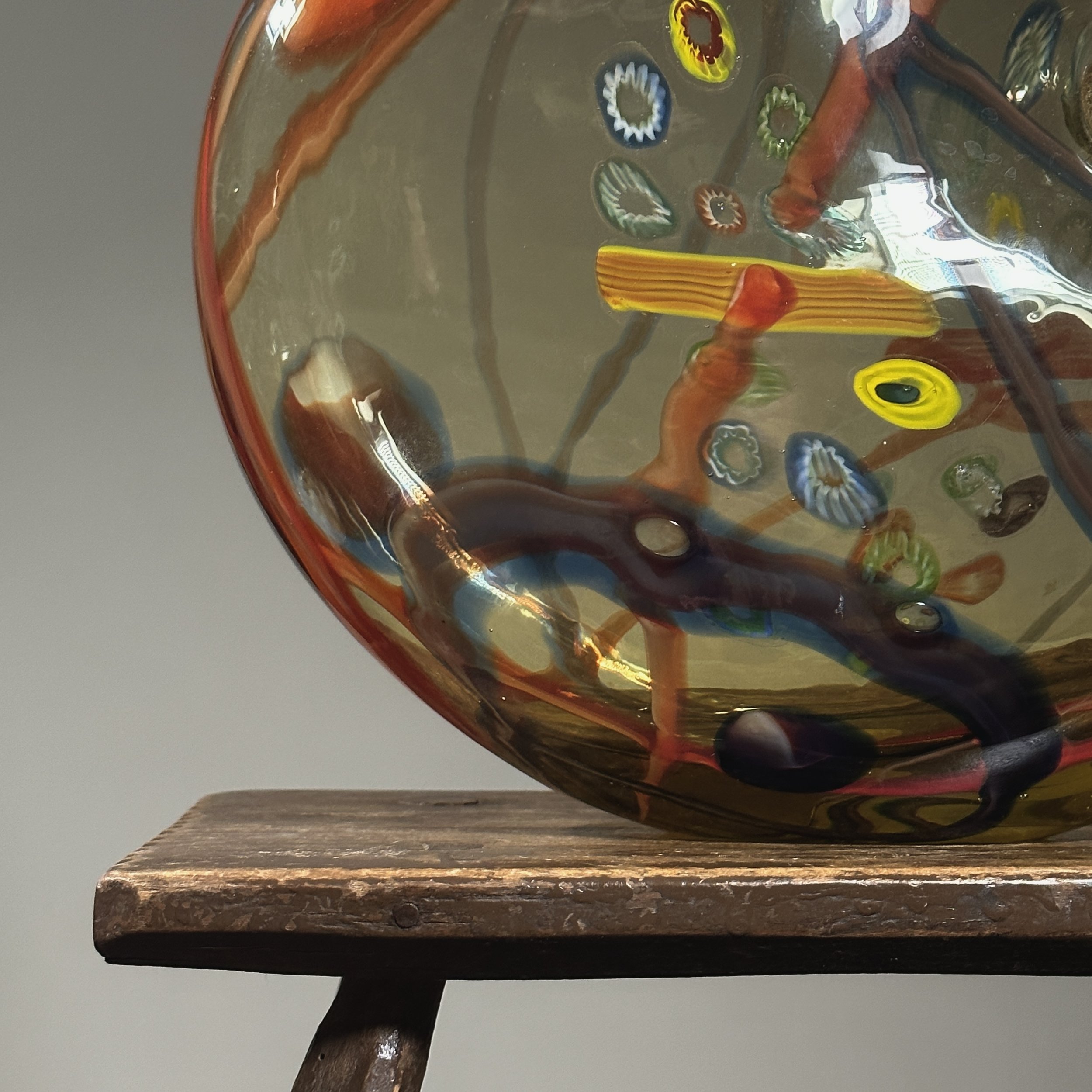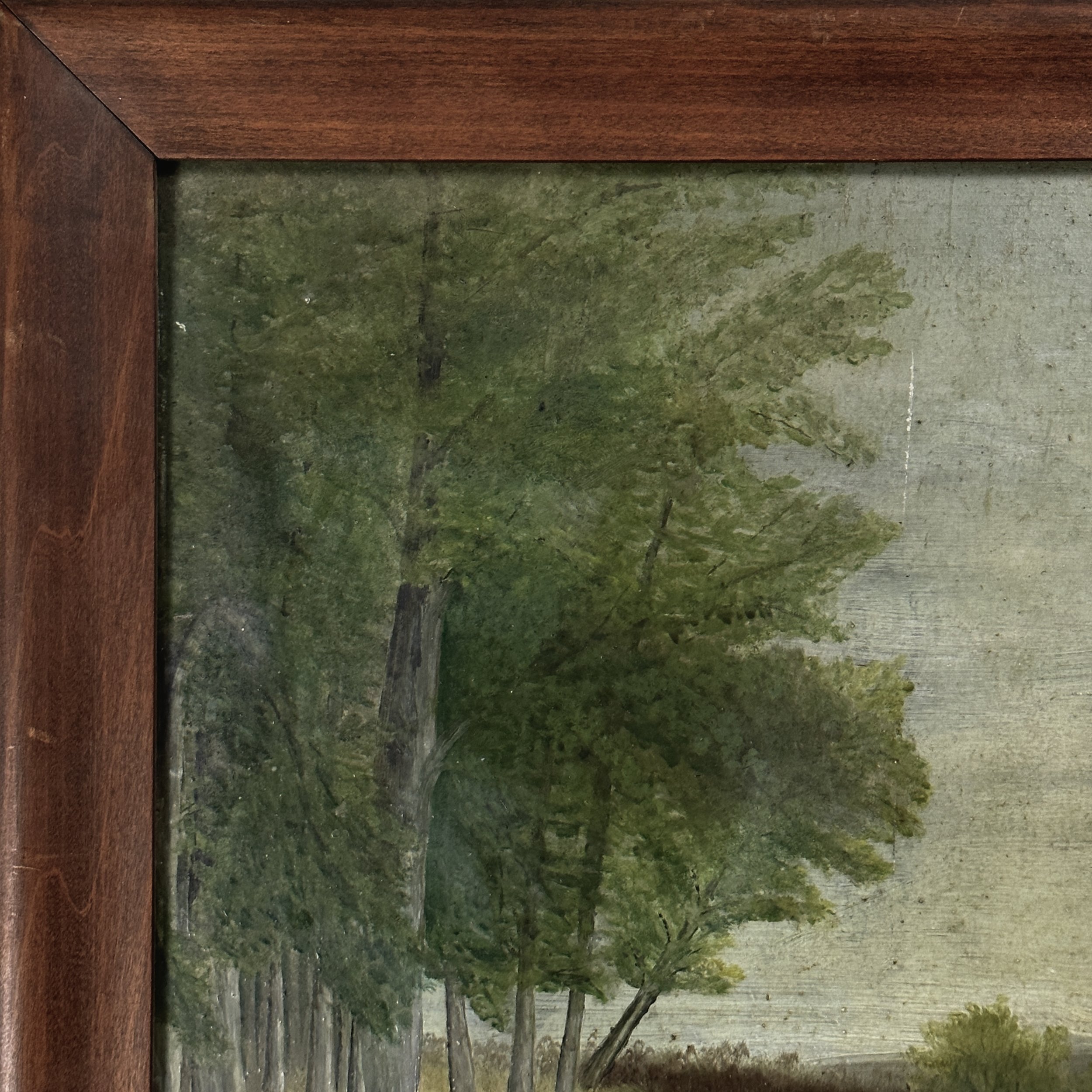Antique American Folk Art Memory Coffee Pot
Antique American Folk Art Memory Coffee Pot with Doll Head Finial. This piece is rare as most memory art were jugs or vases. Includes an original 8 x 10 photo of the piece stamped en verso by the Lancaster Sunday News. In very good condition with wear consistent with age. Some of the small trinkets have fallen out (apparent by the small indentation left behind). Majority of the loss is in the spout area. Please refer to pictures for details.
Memory Art was started in the late 1800s as a way of memorializing the dead. The vessel itself was usually adorned with keepsakes and trinkets that were associated with the person. This particular coffee pot was decorated with shells, watch parts, hinges, medals, porcelain dolls, keys, hour glasses, nuts, etc. held together by a brown putty. Sometimes they were painted all over to achieve a uniform look.
Size: 9.5”H x 12.25”W x 8”D
“As a cultural artifact of the late 19th and early 20th centuries, memory jugs possess an intersectional history as a form of domestic craft with ties to African and African-American burial practices. Traditionally created by the Bakongo people in Central and West Africa as grave markers, memory jugs migrated to the Americas through the importation of slaves and became prevalent in the African-American communities of the South, subsequently merging with the craft pursuits of the Victorian period.
While the specific decoration of the memory vessel possesses a unique biographical meaning, the cultural origins behind the form and its creative intent originate between the Bankongo region of Central and West Africa and the United States. The practice originates in a cultural view of graveyards as a place of commemoration and intersection in which the spirits of the dead may influence the lives of the living if they are not properly commemorated or contained in the spirit realm. In the province of Manianga, tombs are elaborately decorated with fragments of objects associated with the deceased, serving as a means for mourners to engage with their deceased loved ones. The broken objects intended as a rupture point between the spirit and their attachment to the object, thereby placating the spirit but also severing their attachment to the object and also the realm of the living. Manianga commemorative rituals also include cylindrical jars with swirling inscriptions and signs known as bidimbu that serve to praise and contain the spirit of the deceased. With the importation of slaves into the Americas, scholars assert that these distinct traditions blended to form memory vessels that simultaneously housed the spirit, appeased their need for temporal goods, and recalled the domain of the dead through their suggestive decoration.” - John-Duane Kingsley
Antique American Folk Art Memory Coffee Pot with Doll Head Finial. This piece is rare as most memory art were jugs or vases. Includes an original 8 x 10 photo of the piece stamped en verso by the Lancaster Sunday News. In very good condition with wear consistent with age. Some of the small trinkets have fallen out (apparent by the small indentation left behind). Majority of the loss is in the spout area. Please refer to pictures for details.
Memory Art was started in the late 1800s as a way of memorializing the dead. The vessel itself was usually adorned with keepsakes and trinkets that were associated with the person. This particular coffee pot was decorated with shells, watch parts, hinges, medals, porcelain dolls, keys, hour glasses, nuts, etc. held together by a brown putty. Sometimes they were painted all over to achieve a uniform look.
Size: 9.5”H x 12.25”W x 8”D
“As a cultural artifact of the late 19th and early 20th centuries, memory jugs possess an intersectional history as a form of domestic craft with ties to African and African-American burial practices. Traditionally created by the Bakongo people in Central and West Africa as grave markers, memory jugs migrated to the Americas through the importation of slaves and became prevalent in the African-American communities of the South, subsequently merging with the craft pursuits of the Victorian period.
While the specific decoration of the memory vessel possesses a unique biographical meaning, the cultural origins behind the form and its creative intent originate between the Bankongo region of Central and West Africa and the United States. The practice originates in a cultural view of graveyards as a place of commemoration and intersection in which the spirits of the dead may influence the lives of the living if they are not properly commemorated or contained in the spirit realm. In the province of Manianga, tombs are elaborately decorated with fragments of objects associated with the deceased, serving as a means for mourners to engage with their deceased loved ones. The broken objects intended as a rupture point between the spirit and their attachment to the object, thereby placating the spirit but also severing their attachment to the object and also the realm of the living. Manianga commemorative rituals also include cylindrical jars with swirling inscriptions and signs known as bidimbu that serve to praise and contain the spirit of the deceased. With the importation of slaves into the Americas, scholars assert that these distinct traditions blended to form memory vessels that simultaneously housed the spirit, appeased their need for temporal goods, and recalled the domain of the dead through their suggestive decoration.” - John-Duane Kingsley
Antique American Folk Art Memory Coffee Pot with Doll Head Finial. This piece is rare as most memory art were jugs or vases. Includes an original 8 x 10 photo of the piece stamped en verso by the Lancaster Sunday News. In very good condition with wear consistent with age. Some of the small trinkets have fallen out (apparent by the small indentation left behind). Majority of the loss is in the spout area. Please refer to pictures for details.
Memory Art was started in the late 1800s as a way of memorializing the dead. The vessel itself was usually adorned with keepsakes and trinkets that were associated with the person. This particular coffee pot was decorated with shells, watch parts, hinges, medals, porcelain dolls, keys, hour glasses, nuts, etc. held together by a brown putty. Sometimes they were painted all over to achieve a uniform look.
Size: 9.5”H x 12.25”W x 8”D
“As a cultural artifact of the late 19th and early 20th centuries, memory jugs possess an intersectional history as a form of domestic craft with ties to African and African-American burial practices. Traditionally created by the Bakongo people in Central and West Africa as grave markers, memory jugs migrated to the Americas through the importation of slaves and became prevalent in the African-American communities of the South, subsequently merging with the craft pursuits of the Victorian period.
While the specific decoration of the memory vessel possesses a unique biographical meaning, the cultural origins behind the form and its creative intent originate between the Bankongo region of Central and West Africa and the United States. The practice originates in a cultural view of graveyards as a place of commemoration and intersection in which the spirits of the dead may influence the lives of the living if they are not properly commemorated or contained in the spirit realm. In the province of Manianga, tombs are elaborately decorated with fragments of objects associated with the deceased, serving as a means for mourners to engage with their deceased loved ones. The broken objects intended as a rupture point between the spirit and their attachment to the object, thereby placating the spirit but also severing their attachment to the object and also the realm of the living. Manianga commemorative rituals also include cylindrical jars with swirling inscriptions and signs known as bidimbu that serve to praise and contain the spirit of the deceased. With the importation of slaves into the Americas, scholars assert that these distinct traditions blended to form memory vessels that simultaneously housed the spirit, appeased their need for temporal goods, and recalled the domain of the dead through their suggestive decoration.” - John-Duane Kingsley


















































